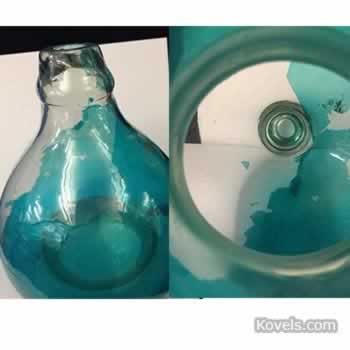There are many temporary and devious ways to improve the appearance of a bottle. In some countries, bottle collectors swish baby oil inside a bottle to coat the inner surface to hide flaws and scratches. This is not okay in the United States, but it used to be acceptable in Australia. Some pottery or dark glass bottles are partially filled with melted paraffin, then swirled until the interior surface is covered and waterproof. This is often done for bottles and vases used for flower arrangements.
At the local public television auction, we accidently discovered an “enhanced” bottle. A collector donated 40 bottles with the warning that some were old, and some were copies. The bottles marked “Wheaton” were easy. Not old. Other figural bottles had raised marks indicating they were not antique. Best fake was a cologne bottle with a small MMA mark. Research online found the same pink bottle in the gift shop at the Metropolitan Museum of Art.
But the surprise was an old light aqua blown bottle with a pontil and a stubby neck. We put it under bright TV studio lights to sell and noticed a corner of the neck was clear. So the bottle was washed and rubbed, and suddenly large cellophane-like pieces were flaking off. It had been “painted” with a clear blue plastic film. Our pictures show the damaged colored “skin.” Did the donor know he had an “enhanced” fake? It looked perfect before it was cleaned.
We have seen many other color changed bottles that are sun-colored amethyst (light lavender jar exposed to sun), irradiated (glass bottles made before c.1920 that were irradiated to dark purple after the 1960s), or made in an old mold with new colored glass (royal blue Mason jar or milk bottle). These are all permanent changes, so beware.




Leave a Reply
You must be logged in to post a comment.